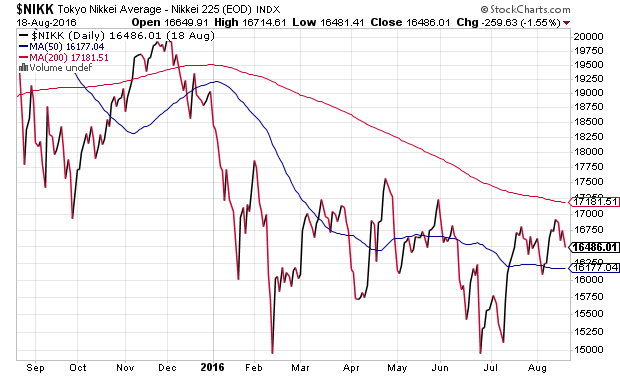What do investors in “high quality” bonds worry about the most? The folks and Bank of America Merrill Lynch Global Research wanted to know. It turns out, investors are increasingly concerned about the bursting of a bubble in credit.

It may not be surprising that nearly one-third of high-grade credit respondents are troubled by the possibility of a sharp reversal in prices. When the Fed announced plans to taper its third round of quantitative easing (“QE3″) in 2013, the Composite Corporate Bond Rate (CCBR) jumped nearly 100 basis points in less than two months. Exchange-traded funds like iShares iBoxx $ Investment Grade Corporate Bond (NYSE:LQD) coughed up 8% in the time frame.

What may be more startling, however, is the sudden appearance of “quantitative failure” on the credit investor’s radar screen. Why? Perhaps because total return gains may morph into total return losses when faith in central bank omnipotence deteriorates.
It may already be happening.
Consider the European Central Bank (ECB) policy of acquiring $80 billion in euro-denominated debt every month. Originally, the ECB targeted sovereign debt alone. When it became clear in June that the ECB would quickly run out of positive yielding debt to buy, let alone bonds with a yield of -0.4% or greater, they shifted attention to corporate bond assets. Now an investor in high-grade European corporate debt is effectively paying companies to borrow.

And it’s not just central banks in Europe that have brought about negative interest rates for one-fourth of the global bond pie. The Bank of Japan (BOJ) introduced negative interest rate policy (NIRP) back in January. Six months later? Not only has NIRP failed to stimulate the Japanese economy itself, but prominent corporations have publicly stated that BOJ intervention has made the corporate bond market treacherous.
Remember, the central bank of the United Stated (a.k.a. Federal Reserve or “Fed”) was content to scoop up treasury bonds as well as mortgage-backed securities in its rate manipulating endeavors. The ECB went one step further in its decision to go after corporate bonds. The BOJ? They moved into the stock arena to set themselves up as a top 10 shareholder in 90% of the companies in the Nikkei 225. If quantitative easing still reflates asset prices, then why is the Nikkei 225 faring so poorly?

Faith in central bank policies like quantitative easing (QE) and negative interest rate policy (NIRP) may already be eroding. Granted, one might argue that the global economy as well as global asset prices (e.g., stocks, bonds, etc.) would be far worse off in the absence of unconventional stimulus. Moreover, faith in the Federal Reserve remains robust enough for U.S. stocks and bonds to simultaneously sit near record highs.
On the flip side, we’ve been down a similar pathway of blind faith before. Remember the “New Economy” in the late 1990s? Analysts everywhere had proclaimed that the Internet had changed the way stocks (particularly technology stocks) should be valued. They were sorely mistaken. In the mid 2000s, group-thinkers opined that home prices are only capable of going one direction. Up. That wasn’t accurate either.
It follows that if the world’s investors can lose faith in the capability of the European Central Bank (ECB) as well as the Bank of Japan (BOJ), they’re capable of losing faith in the Fed. And should that transpire, it may not matter what monetary policy leaders say or do. Asset prices – stocks, bonds, real estate – they could deflate faster than they inflated. Indeed, disintegrating faith may be a bigger threat than the actuality that the ECB and BOJ have been running out of monetizable bonds.
Ironically enough, the central bank engineered credit boom is already showing cracks in the foundation. High grade debt has swelled from $2 trillion in 2008 to north of $5.5 trillion today. Since most of the money has gone directly into share buybacks or dividends, as opposed to productive assets for the benefit of long-term company well-being, corporations will have to borrow again when current debts mature. Will those low borrowing costs be there down the road? Will today’s over-leveraging be tomorrow’s ruination?

One thing’s for certain. The insane rise in corporate net debt has occurred alongside a significant decline in operating performance. Quantitative easing by the world’s central banks? It may have done little more than fuel excessive borrowing by companies and governments that will agonize to stay afloat.

Worse yet? The investment community may soon shift from fear of “quantitative failure” to fear of losing capital. And when that day arrives, the overexposed are likely to scamper to protect themselves. The positive sloping price ratio between gold and the S&P 500 – the ratio between SPDR Gold Trust (GLD (NYSE:GLD)) and SPDR S&P 500 (NYSE:SPY) – may be an indication that a shift is already in the works.

Disclosure: Gary Gordon, MS, CFP is the president of Pacific Park Financial, Inc., a Registered Investment Adviser with the SEC. Gary Gordon, Pacific Park Financial, Inc, and/or its clients June hold positions in the ETFs, mutual funds, and/or any investment asset mentioned above. The commentary does not constitute individualized investment advice. The opinions offered herein are not personalized recommendations to buy, sell or hold securities. At times, issuers of exchange-traded products compensate Pacific Park Financial, Inc. or its subsidiaries for advertising at the ETF Expert web site. ETF Expert content is created independently of any advertising relationships.
